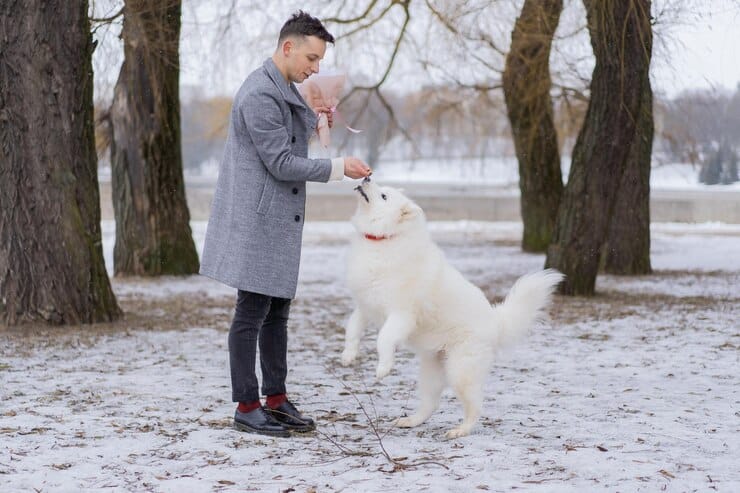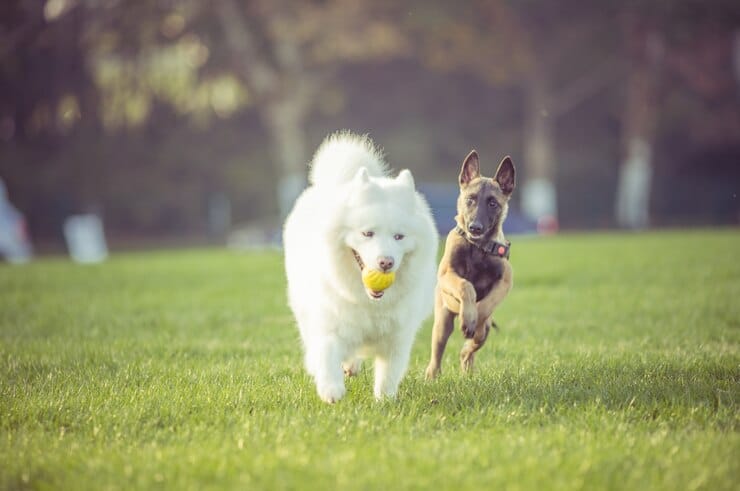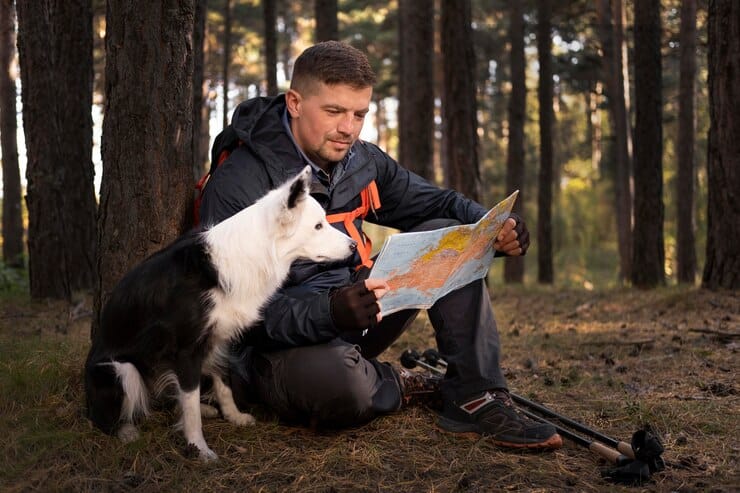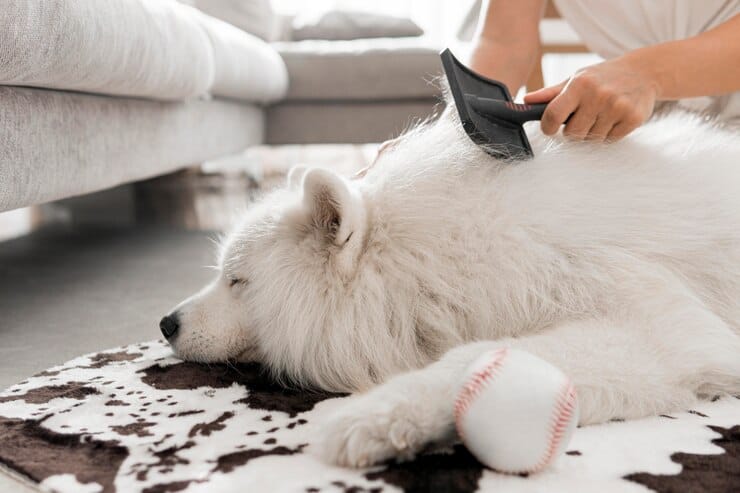When it comes to training Samoyeds, many potential dog owners ask, "Are Samoyeds easy to train?" These stunning dogs, known for their fluffy coats and friendly smiles, possess a mix of intelligence and independence, making their training an interesting journey.

Exploring the Intelligence and Trainability of Samoyeds
Samoyeds are bright and quick learners, but their independent nature can sometimes pose a challenge in training. This unique combination requires a strategic approach to harness their intelligence effectively.
Early Training: Shaping a Samoyed Puppy
The key to a well-trained Samoyed lies in early socialization and training. Introducing your Samoyed puppy to a variety of experiences, people, and animals lays the groundwork for a sociable and adaptable adult dog.
Mastering Effective Training Techniques for Samoyeds
1. Embracing Positive Reinforcement
Positive reinforcement is the most effective method for training Samoyeds. Rewards such as treats, praise, and playtime make learning enjoyable and reinforce desired behaviors, fostering a strong bond between you and your dog.
2. The Role of Consistency
Consistency in commands, routines, and expectations is crucial for effective training. A consistent approach reduces confusion and helps your Samoyed understand and follow the rules more easily.
Tackling Training Challenges with Samoyeds
While Samoyeds are intelligent, their occasional stubbornness can test your patience. Staying calm and consistent, even when challenges arise, is important. If a training method isn’t working, be flexible and try different techniques, or seek advice from professional trainers.
A Vital Part of Samoyed Training
Housebreaking should be a priority in your training regimen. Establish a consistent schedule for feeding and bathroom breaks, and be patient during the learning process. Understand that accidents are part of the journey and handle them with patience.
The Importance of Socialization in Samoyed Training
A well-rounded training program for Samoyeds includes extensive socialization. Exposing your dog to different settings, sounds, and experiences is crucial for their emotional development and helps prevent anxiety and fearfulness.
Advancing Beyond Basic Training
Once you've established the fundamentals with your Samoyed, it's beneficial to advance to more complex training. This can include obedience classes, agility training, or learning advanced commands. Engaging your Samoyed in these activities not only stimulates their mind but also reinforces their training and strengthens your communication with them.
Incorporating Fun into Training
Remember, training doesn't have to be all work and no play. Integrating games and fun activities into the training process can significantly enhance their learning experience. Games like fetch, hide and seek, and interactive toys can be both entertaining and educational for your Samoyed.

Handling Distractions and Social Challenges
Samoyeds are naturally curious and social, which can sometimes lead to distraction during training. Training them to focus in the presence of distractions is crucial. This can be gradually achieved by training in different environments and introducing new stimuli in a controlled manner.
Training a Samoyed for Different Environments
A comprehensive training program for your Samoyed should also include adapting them to various environments. Whether it’s city streets, crowded parks, or peaceful countryside, helping your Samoyed navigate different settings confidently is essential for a well-adjusted dog.
Health and Training: A Vital Connection
Physical health and well-being are closely tied to training success. Regular health check-ups, a balanced diet, and adequate exercise can significantly impact your Samoyed’s ability to learn and retain training. A healthy Samoyed is more likely to be an attentive and enthusiastic learner.
The Long-Term Benefits of Training Your Samoyed
The benefits of training your Samoyed extend far beyond basic commands and behaviors. It leads to a safer environment for both the dog and others, enhances the bond between you and your pet, and ensures a harmonious coexistence. Well-trained Samoyeds are more likely to be sociable, confident, and content.
Enhancing Communication through Training
Effective communication is at the heart of training your Samoyed. Understanding their body language and cues, and teaching them to understand yours, is fundamental. This deepens the mutual understanding and respect, making training sessions more effective and enjoyable.
The Role of Patience in Training
Patience cannot be overstated when it comes to training Samoyeds. They may not respond immediately or may test boundaries. Remember, each dog learns at their own pace, and patience coupled with encouragement will yield the best results.
Advanced Socialization Techniques
While basic socialization is crucial, advancing to more complex socialization scenarios is important for Samoyeds, especially given their friendly nature. This includes exposing them to different types of environments, noises, and even other animals, ensuring they remain well-behaved and calm in various situations.
The Importance of a Routine
Establishing a routine helps Samoyeds understand what is expected of them and when. This includes regular training sessions, feeding times, and exercise schedules. A routine provides a sense of security and structure, making training more effective.
Ongoing Training: A Lifelong Commitment
Training your Samoyed is not a one-time task but a continuous process. Reinforcing learned commands, introducing new challenges, and revisiting training concepts regularly help keep your Samoyed engaged and well-behaved throughout their life.
The Joy of Achievements in Training
Celebrating milestones in your Samoyed’s training journey is important. Acknowledge both small and big achievements, as this reinforces positive behaviors and keeps the training experience positive for both of you.
Embracing the Unique Personality of Your Samoyed in Training
Every Samoyed has a unique personality, and recognizing this individuality is key in training. Tailoring your training approach to suit your dog's specific temperament and learning style can make a significant difference. Some may respond better to certain types of rewards or training environments than others.
The Value of Professional Training Resources
Don't hesitate to seek professional help if needed. Dog trainers, behaviorists, and obedience classes can provide valuable guidance and support, especially in addressing specific training challenges or advancing your Samoyed's skills.

Incorporating Mental Stimulation into Training
Mental stimulation is just as important as physical exercise for Samoyeds. Integrating training activities that challenge their minds, like scent work or trick training, can keep them mentally sharp and prevent boredom.
The Impact of Consistent Leadership
Your role as a consistent leader is crucial in training. Samoyeds, with their pack dog heritage, respond well to clear and confident leadership. This doesn't mean being harsh or domineering; rather, it's about being firm, fair, and consistent in your training approach.
Recognizing and Adapting to Training Plateaus
It's normal to encounter plateaus in training where progress seems to stall. Recognizing these and adapting your methods, whether through introducing new challenges or revisiting basic commands, can help overcome these plateaus.
The Lifelong Journey of Training and Learning
Training your Samoyed is a lifelong journey that evolves as they grow and change. What works during puppyhood might need adjustment as they mature. Be prepared to adapt your training methods as your Samoyed ages and their needs change.
Fostering a Positive Learning Environment
Creating a positive and encouraging learning environment is essential for effective training. This means avoiding negative reinforcement or punishment, which can lead to fear and distrust. Instead, focus on building a nurturing space where your Samoyed feels safe and eager to learn.
The Benefits of Group Training Sessions
Consider enrolling your Samoyed in group training sessions. This not only provides professional guidance but also offers an excellent opportunity for socialization. Observing other dogs can be a powerful motivator for your Samoyed and can enhance the training experience.
Addressing Behavioral Challenges
Samoyeds, like any breed, can develop behavioral issues. Early intervention is key. If you notice any concerning behaviors, address them promptly through targeted training or professional help. This proactive approach can prevent minor issues from becoming major problems.
Celebrating the Small Victories
In training, every small victory is significant. Whether it’s mastering a new command or successfully interacting in a social setting, celebrate these moments. This not only motivates your Samoyed but also reinforces your bond and makes the training journey enjoyable for both of you.
The Role of Exercise in Training
Adequate exercise is vital for a Samoyed’s overall well-being and aids in training. A well-exercised dog is typically more focused and less prone to disruptive behaviors. Ensure your Samoyed gets enough physical activity to meet their breed-specific needs.
Incorporating Flexibility in Your Training Approach
Flexibility is key in training a Samoyed. Be prepared to adjust your methods if something isn't working. Dogs, like people, have different learning styles, and what works for one may not work for another. Be open to trying different techniques and strategies to find what resonates best with your Samoyed.
The Power of Routine and Boundaries
While flexibility is important, so is establishing a routine and clear boundaries. Samoyeds, with their keen intelligence, quickly understand what is expected of them when there is consistency. This clarity helps in reducing confusion and building a disciplined yet loving relationship.
Utilizing Technology and Modern Training Tools
Leverage technology and modern training tools available today. From training apps to interactive toys, these resources can provide innovative ways to engage and train your Samoyed, making the process more efficient and enjoyable.
The Importance of Health in Training
Remember, a healthy dog is a trainable dog. Regular vet check-ups, a nutritious diet, and proper care are foundational to successful training. Health issues can affect a dog’s mood and ability to learn, so staying on top of your Samoyed's health is crucial.
The Reward of a Well-Trained Samoyed
A well-trained Samoyed is not just a joy to have around; they also represent the deep connection and understanding you’ve developed with them. This journey enhances the quality of life for both you and your dog, making every effort and time spent in training worthwhile.
Nurturing Lifelong Learning and Adaptation
Training your Samoyed is a continuous, lifelong process. As your dog matures and ages, their learning and training needs will evolve. Stay attuned to these changes and be ready to adapt your training methods accordingly. This ongoing commitment to training ensures that your Samoyed remains engaged, well-behaved, and mentally stimulated throughout their life.
The Joy of Shared Activities
Integrating training into everyday activities can enhance the learning experience for both you and your Samoyed. Incorporate training cues into playtime, walks, and daily routines. This not only reinforces learned behaviors but also makes training a natural and enjoyable part of your daily interaction.
Balancing Discipline and Affection
A balanced approach of discipline and affection is essential in training. While it's important to be firm and consistent, it's equally important to show love and affection. This balance helps in building a relationship based on respect and trust, essential for effective training.
The Role of Personalized Training Plans
Consider creating a personalized training plan tailored to your Samoyed's individual needs, personality, and learning pace. This plan can include specific goals, training methods, and a schedule that suits both you and your dog. Regularly review and adjust this plan as needed to ensure it remains effective and relevant.

Emphasizing Safety in Training
Safety should always be a priority in training. Ensure that the training environment is safe and free from hazards. When training outdoors or in public spaces, be mindful of your surroundings to prevent any risky situations for your Samoyed.
Celebrating the Unique Bond with Your Samoyed
Lastly, training is more than just teaching skills; it's about celebrating the unique bond you share with your Samoyed. Each training session is an opportunity to strengthen this bond and build lasting memories together. Cherish these moments, and take pride in the progress and achievements you both make.
Conclusion:
In summary, training a Samoyed is a rewarding journey that combines intelligence, patience, and adaptability. Early socialization, consistent routines, and positive reinforcement are key. Tackling challenges with patience, incorporating fun into training, and understanding each dog's unique personality enhance effectiveness.
Regular health checks, exercise, and a balanced approach of discipline and affection are crucial. Utilizing technology, group training, and continuous learning adapt to your Samoyed's evolving needs. Embrace this journey not just as a task but as an opportunity to strengthen your bond, ensuring your Samoyed is not only well-trained but also a happy, integral part of your life.
Frequently Asked Questions
1. Are Samoyeds easy to train compared to other breeds?
- Samoyeds are intelligent and capable of learning quickly, but their independent nature can make training a bit challenging. With consistent, positive reinforcement training methods, they can be effectively trained.
2. What is the best age to start training a Samoyed?
- Training should start as soon as you bring your Samoyed home, regardless of age. For puppies, this can be as early as 8 weeks. Early socialization and basic command training are crucial in their formative weeks and months.
3. Can Samoyeds be trained for obedience competitions?
- Yes, Samoyeds can be trained for obedience competitions. Their intelligence and eagerness to please, when harnessed with consistent training, can make them good candidates for such competitions.
4. How important is socialization in training a Samoyed?
- Socialization is extremely important for Samoyeds. It helps them become well-adjusted adults, comfortable in various situations and environments, and is a critical component of their overall training.
5. Are there specific training challenges with Samoyeds?
- Samoyeds may exhibit stubbornness due to their independent nature. Additionally, their high energy levels and intelligence mean they can get bored easily, so training sessions should be engaging and varied.
6. What training methods work best for Samoyeds?
- Positive reinforcement methods, including treats, praise, and play, are highly effective for Samoyeds. Consistency and patience are also key components of successful training.
7. How can I keep my Samoyed focused during training sessions?
- Keeping training sessions short, fun, and engaging can help maintain your Samoyed’s focus. Training in a distraction-free environment initially can also help, gradually introducing distractions as they become more proficient.
8. Can Samoyeds be house-trained easily?
- Samoyeds, like any breed, can be house-trained effectively with consistency, patience, and a regular routine for meals and bathroom breaks.
9. Do Samoyeds require professional training classes?
- While not always necessary, professional training classes can be beneficial, especially for first-time Samoyed owners or for addressing specific training challenges.
10. Is it necessary to use a firm hand in training Samoyeds?
- Rather than being overly firm or harsh, Samoyeds respond best to confident, consistent, and calm training approaches. Clear boundaries and a positive environment are more effective.




